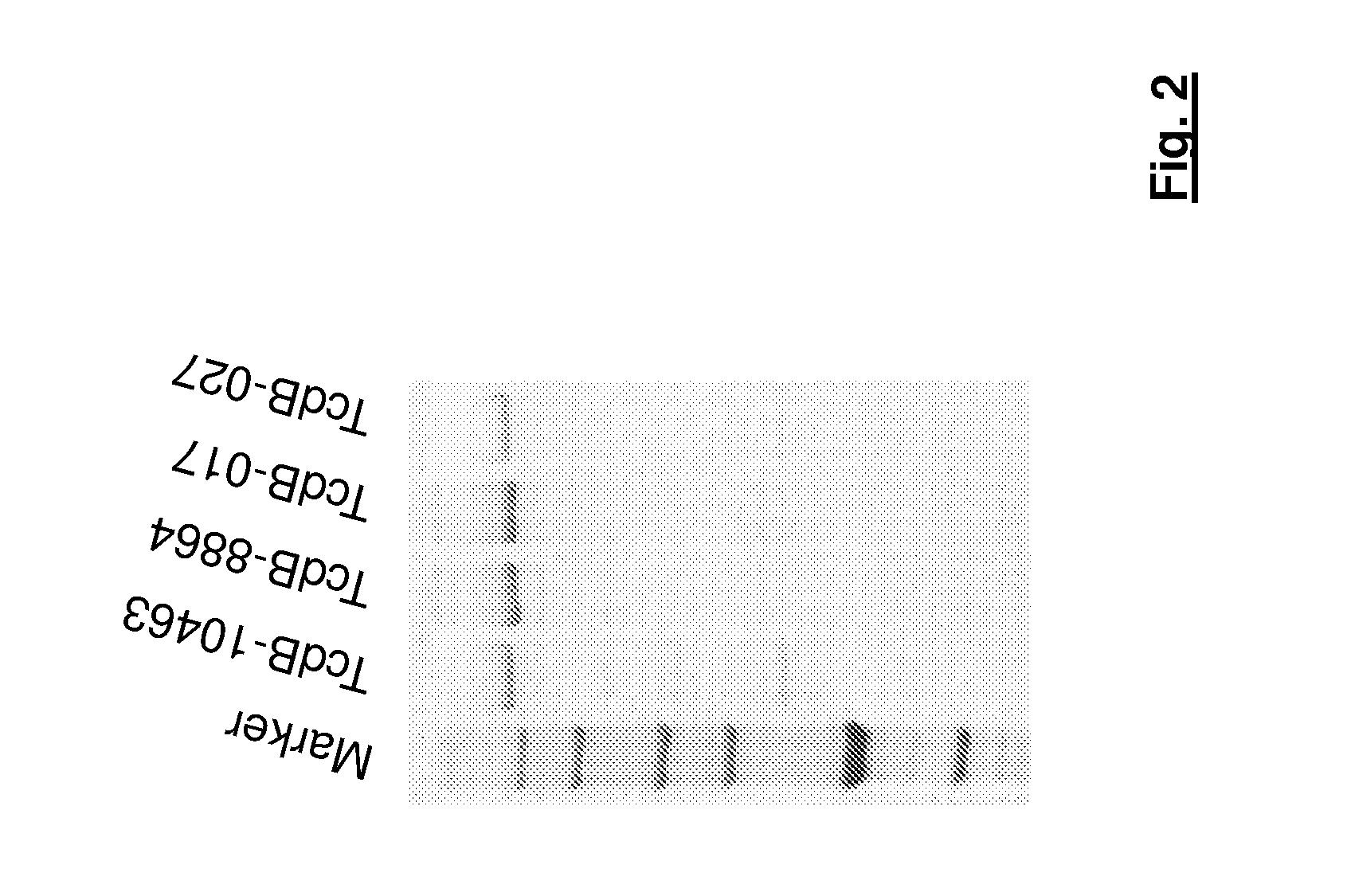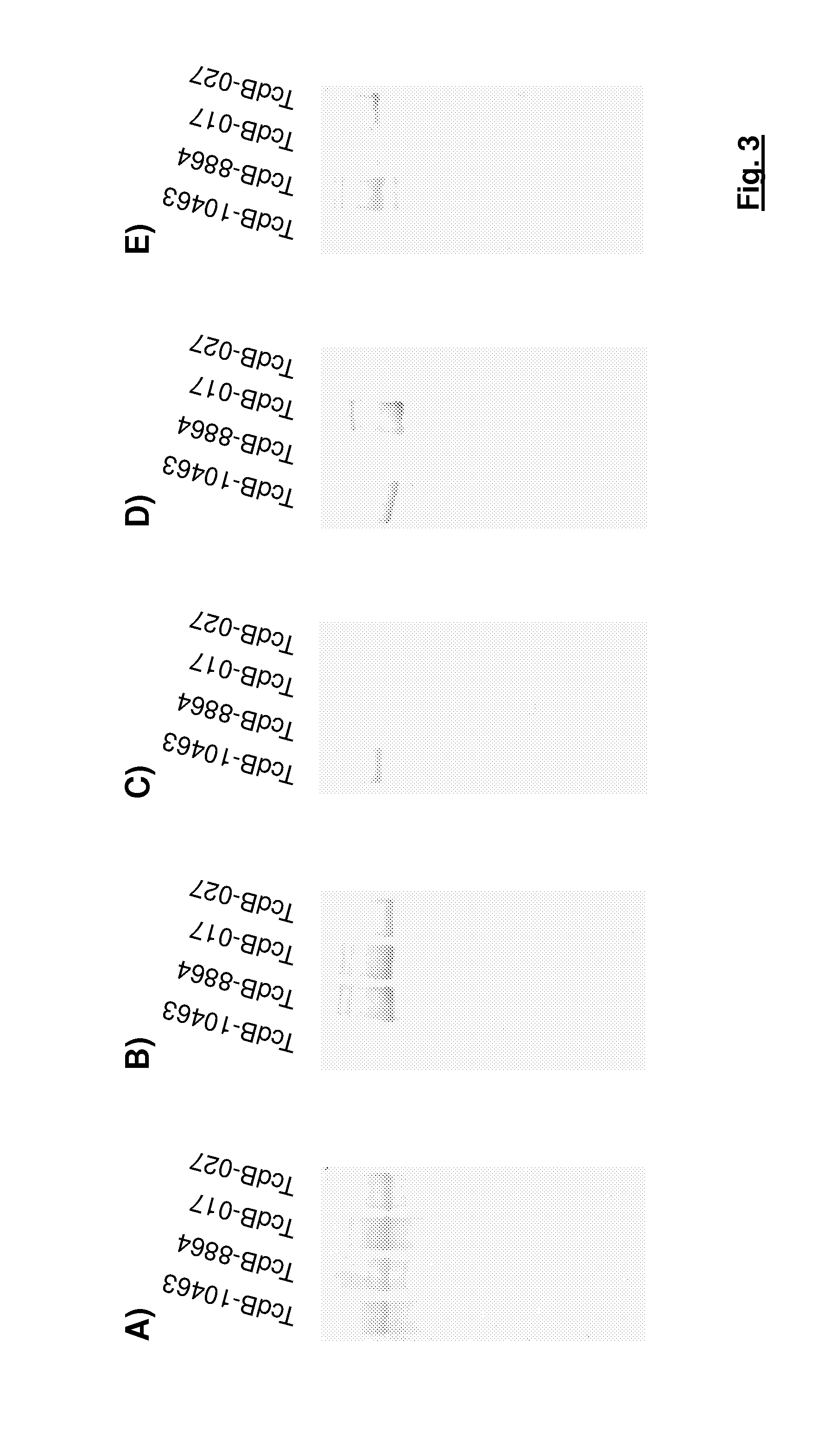Method for the detection and identification of a variant C. difficile strain in a sample
sample technology, applied in the field of method for the detection and identification of a variant c. difficile strain in a sample, can solve the problems of complex prior isolation of i>c, work and time-consuming methods, and the like, and achieve the effect of saving costs
- Summary
- Abstract
- Description
- Claims
- Application Information
AI Technical Summary
Benefits of technology
Problems solved by technology
Method used
Image
Examples
example 1
Generation of Monoclonal Antibodies which React Specifically with Toxin B from C. difficile
(A) Production of Purified C. difficile Toxin B from Various C. difficile Strains
[0089]The following C. difficile strains were used:[0090]VPI-10463 (ATCC 43255),[0091]8864 (CCUG 20309),[0092]1470 (ATCC 43598), and[0093]7002 / 8 (human isolate from a sample from a patient)
[0094]The strains were ribotyped in accordance with the ribotyping method described by Stubbs et al in 1999. The results obtained are shown in FIG. 1. It becomes obvious that strain 1470 corresponds to ribotype 017 and strain 7002 / 8 to ribotype 027, while strains VPI-10463 and 8864 must be assigned to as yet not officially named ribotypes.
[0095]The toxin B (TcdB-10463) expressed by strain VPI-10463 is generally described in the art as standard toxin.
[0096]Strain 8864 produces a variant of this toxin B (TcdB-8864) which differs from the standard toxin primarily in the C-terminal receptor binding domain (Soehn et al, 1998).
[0097]...
example 2
Characterization of Anti-toxin B Antibodies
[0105]In order to characterize the antibodies generated in Example 1, they were tested using Western blot.
[0106]To this end, initially each time 250-400 ng of standard toxin B 10463 and the toxin B variants TcdB-8864, TcdB-017 and TcdB-027 were separated in SDS PAGE and then blotted in a semi-dry blotting procedure on nylon membranes. They were developed using routine methods which are known in the art.
[0107]In order to detect the toxins, the monoclonal antibodies generated in Example 1 were used.
[0108]The results for the antibodies with the laboratory references TGC 16, TGC 19, TGC 23, TGC 35 and TGC 41 are summarized in FIG. 3.
[0109]The results show that most of the generated antibodies recognize a sub group of various toxin B variants rather than a particular mono-specific toxin variant.
[0110]In total 11 different antibodies were identified which bind to the standard toxin B and to all toxin B variants. A characteristic representative of...
example 3
Detection of LCTs in trap ELISA—Construction of Antigen-antibody Reference Patterns for known Variant C. difficile Strains Using Antibody Groups I, II, IV and VI
[0132]Antigen-antibody reference patterns were basically carried out as follows: at least toxin
[0133]B, preferably both large clostridial toxins (LCTs), were obtained (in the form of a culture supernatant or purified toxin) from C. difficile strains Rx1, Rx2, Rxi which were known in the art and which were to be tested for their presence in the detection test. These known toxins LCT-Rx1, LCT-Rx2, LCT-Rxi were used to carry out a reaction test with at least one antibody preferably from each of antibody groups I to VI. The reaction results obtained for each LCT (LCT-Rx1, LCT-Rx2, LCT-Rxi) and the antibody groups employed were set out in a pattern whereby each antibody group was assigned either a positive symbol (for example “+”) if a positive antibody reaction was detected or a negative symbol (for example “−”) if a negative an...
PUM
| Property | Measurement | Unit |
|---|---|---|
| Strain point | aaaaa | aaaaa |
Abstract
Description
Claims
Application Information
 Login to View More
Login to View More - R&D
- Intellectual Property
- Life Sciences
- Materials
- Tech Scout
- Unparalleled Data Quality
- Higher Quality Content
- 60% Fewer Hallucinations
Browse by: Latest US Patents, China's latest patents, Technical Efficacy Thesaurus, Application Domain, Technology Topic, Popular Technical Reports.
© 2025 PatSnap. All rights reserved.Legal|Privacy policy|Modern Slavery Act Transparency Statement|Sitemap|About US| Contact US: help@patsnap.com



